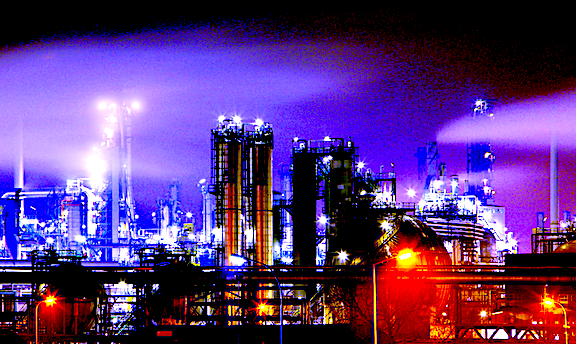Methane is the primary component of natural gas. As a country, the United State has been rapidly transitioning, and continues to transition from coal to natural gas as the fuel of choice for generating electrical power. That’s a good-news story for the environment because natural gas produces about half of the CO2 emissions per kWh. As such, the oil & gas industry views natural gas as a “bridge fuel” until such time that a zero or near-zero emissions energy source is available and can deliver dispatchable electricity. But, as I’ve discussed previously in The RAM Review and elsewhere, fugitive natural gas emissions are spoiling the good news story.
When one thinks of a greenhouse gas (GHG), CO2 is the gas that normally comes to mind. There are, however, other GHGs, including methane (CH4), the primary component of natural gas. Depending upon its age in the atmosphere, methane is between 25 and 80 times as powerful a GHG as CO2. The most reliable estimate of fugitive-natural-gas emissions is 2.3% of the total production in the U.S. In round numbers, we produce about 40 billion Mcf (thousand cubic feet) of natural gas per year. Assuming the 2.3% estimate, nearly one billion Mcf is lost to fugitive emissions. Methane weighs about 0.0192 metric tons per Mcf, equating to about 52 Mcf per metric ton.
The U.S. natural gas industry releases about 18 million metric tons of methane to the atmosphere per year. Assuming an average CO2-equivalent multiplier of 50, the GHG impact of these fugitive methane emissions in the United State is equivalent to about 900 million metric tons of CO2. If you assume a social cost of carbon (SCC) impact of $45 per metric ton of CO2, the SCC is about $40 Billion per year. Even a conservative SCC of $20 Billion per year is an alarmingly large number.
In 2016, the Environmental Protection Agency (EPA) created regulations designed to limit fugitive methane emissions. On August 13, 2020, the EPA rescinded these regulatory requirements for the oil & gas industry in the productions, processing, transportation, storage and distribution of natural gas. One would think that the oil & gas industry would be elated to have these regulatory restrictions rolled back. However, oil & gas behemoths Shell, British Petroleum and Exxon Mobil are saying “no” to the rollbacks. They don’t want to compromise the branding of natural gas as a “bridge fuel.” It’s is likely that “big oil & gas” will continue to diligently manage fugitive emissions.

The reality, though, is that smaller and/or short-sighted operators in the natural gas industry are more likely to take shortcuts in the interest of cost management. For these organizations, the existence of regulations to which they must comply have proven to be quite beneficial. The bottom line, in my opinion, is that the big players in the oil & gas industry want to preserve the 2016 methane-emission regulations to keep the myopic players in check.
Managing fugitive-natural-gas emissions makes good environmental sense. regardless of a person’s politics, even if he or she believes climate change is a “hoax.” it still makes good business sense to diligently manage fugitive natural gas emissions with a focused leak detection and repair (LDAR) initiative. Assuming a selling price of $3 per Mcf, fugitive natural gas emissions account for about $2.7 Billion that, if eliminated, goes straight to the bottom line (EBITDA). Moreover, methane is highly flammable. It’s not uncommon for natural gas leak-related fires to destroy equipment and, in some cases, result in injury or death. The business justifications for controlling fugitive methane emissions are significant.
Since most fugitive emissions of natural gas lost via leaks are from so-called “super emitters,” the 80:20 rule generally applies. Detecting these leaks is relatively straightforward. Specially tuned infrared cameras can easily detect them. Airborne ultrasonic analysis can also detect leaks and help you localize them. Fixing leaks typically is a simple fastener issue that involves addressing faulty flanges, gaskets, valves, and the other components. Over time, a defect-management process will reveal preventive maintenance routines.
All politics aside, and irrespective of your personal position on climate change, taking dead aim at fugitive-natural-gas emissions represents a significant value proposition:. You don’t need a federal regulation to do the right thing for your business and to protect the integrity of your assets and the safety of your people.TRR
ABOUT THE AUTHOR
Drew Troyer has 30 years of experience in the RAM arena. Currently a Principal with T.A. Cook Consultants, he was a Co-founder and former CEO of Noria Corporation. A trusted advisor to a global blue chip client base, this industry veteran has authored or co-authored more than 250 books, chapters, course books, articles, and technical papers and is popular keynote and technical speaker at conferences around the world. Drew is a Certified Reliability Engineer (CRE), Certified Maintenance & Reliability Professional (CMRP), holds B.S. and M.B.A. degrees, and is Master’s degree candidate in Environmental Sustainability at Harvard University. Contact him directly at 512-800-6031 or dtroyer@theramreview.com.
Tags: reliability, availability, maintenance, RAM, predictive maintenance, PdM, process safety, environmental safety, climate change, sustainable manufacturing, fugitive emissions, methane, greenhouse gas



